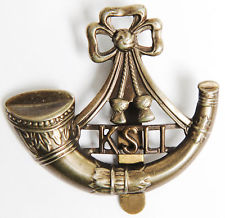Personal Details
Born: 15 March 1895 in Bewdley, Worcestershire.
Family: He lived with his mother, Middie Wagstaff (maiden name Siviter), father, Alfred J Wagstaff and his younger brother, Harry and younger sister, Ena May. He married Hilda E. Minshall in 1920 in Whitchurch, Shropshire. They had three children – Richard A, George E. and Harry L.
Residence: The 1901 census shows him living at 6 St. Mark Street, Uxbridge Place, Birmingham. The 1911 census shows that the family had moved to Whitchurch, Shropshire at 3 West End, 3 Small Brook Road which is still his address on the 1919 Absent Voters’ List. The 1939 Register shows him living at 42 Belton Road, Whitchurch; his address at the time of his death was 7 Meadow View Road, Whitchurch, Shropshire.
Employment: He was an engineer’s warehouseman (1911 Census) and boot repairer (1939 register).
Died: 14 July 1975 in Whitchurch, Shropshire.
Military Details
Regiment: King’s Shropshire Light Infantry, 4th Battalion
Rank: Private
Service Number: 200773 (previously 2421)
Date of Enlistment: October 1914
Date of Discharge: May 1918
Reason for Discharge: No longer physically fit for War Service
Other Information: Frederick’s brother, Harry Wagstaffe, also served in WW1.
Frederick was awarded the Campaign Medals (British War Medal and Victory Medal) and Silver War Badge (number 420544).

The British War Medal (also known as 'Squeak') was a silver or bronze medal awarded to officers and men of the British and Imperial Forces who either entered a theatre of war or entered service overseas between 5th August 1914 and 11th November 1918 inclusive. This was later extended to services in Russia, Siberia and some other areas in 1919 and 1920. Approximately 6.5 million British War Medals were issued. Approximately 6.4 million of these were the silver versions of this medal. Around 110,000 of a bronze version were issued mainly to Chinese, Maltese and Indian Labour Corps. The front (obv or obverse) of the medal depicts the head of George V. The recipient's service number, rank, name and unit was impressed on the rim.
The Allied Victory Medal (also known as 'Wilfred') was issued by each of the allies. It was decided that each of the allies should each issue their own bronze victory medal with a similar design, similar equivalent wording and identical ribbon. The British medal was designed by W. McMillan. The front depicts a winged classical figure representing victory. Approximately 5.7 million victory medals were issued. Interestingly, eligibility for this medal was more restrictive and not everyone who received the British War Medal ('Squeak') also received the Victory Medal ('Wilfred'). However, in general, all recipients of 'Wilfred' also received 'Squeak' and all recipients of The 1914 Star or The 1914/1915 Star (also known as 'Pip') also received both 'Squeak' and 'Wilfred'. The recipient's service number, rank, name and unit was impressed on the rim.

The Silver War Badge was issued in the United Kingdom and the British Empire to service personnel who had been honourably discharged due to wounds or sickness from military service in World War I. The badge, sometimes known as the "Discharge Badge", the "Wound Badge" or "Services Rendered Badge", was first issued in September 1916, along with an official certificate of entitlement.

